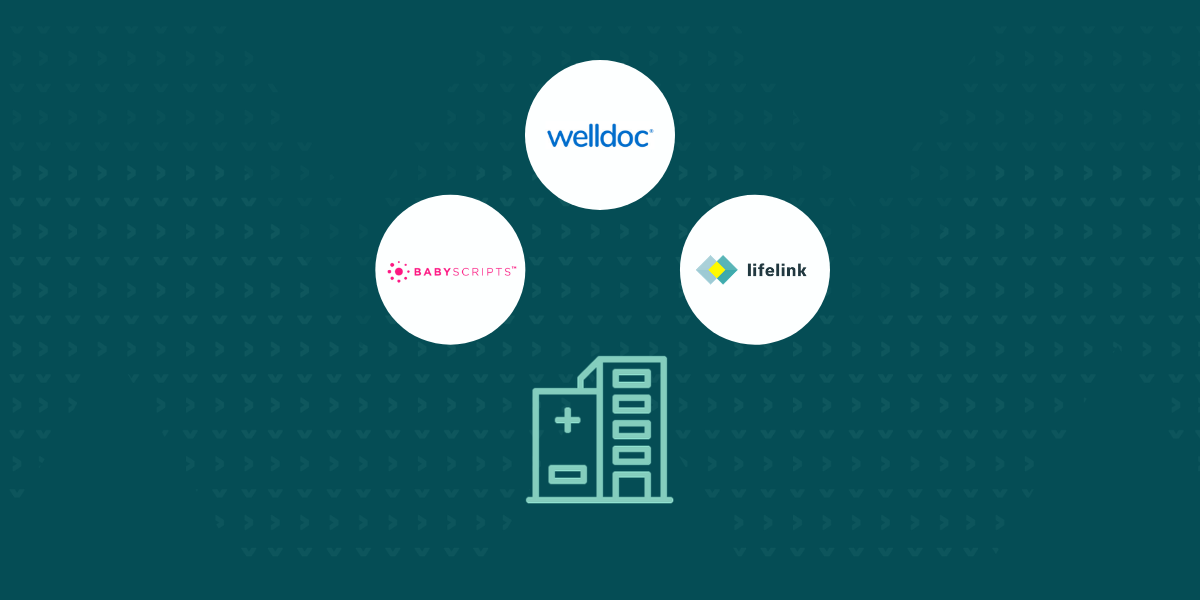3 digital tools changing how patients engage with healthcare
Mar 25, 2020

When patients get involved with their care, great things happen. Research suggests that when patients are engaged, they’re more likely to take medications as prescribed, monitor their condition and care for themselves, all of which lead to better outcomes.
As evidence supporting the benefits of patient engagement grows, providers are partnering with companies focused on helping patients manage their health. These companies are building unique, personalized relationships with patients and giving them the tools to get and stay well.
Below are a few examples of smart companies that are changing how patients engage with their healthcare.
Welldoc
Diabetes is a very common condition in the United States. In fact, 34.2 million people – or about 10.5% of the U.S. population – were known to have diabetes as of 2018.
On average, caring for such patients costs almost $17,000 per patient each year, or 2.3 times as much as care for patients without the condition. However, if patients improve their diabetes management behavior, these costs can be reduced dramatically. The question is how to make that happen.
One company working to tackle this problem is Welldoc, which uses digital health tools and AI technology to help such patients manage their condition more effectively.
Welldoc has developed an application, known as BlueStar, designed to give diabetic patients guidance and feedback that can help them better maintain their health. Its overall purpose is to improve patient outcomes and cut down on excess care costs.

BlueStar, which has been approved by the FDA, uses AI to generate specialized advice to each patient based on factors such as their activity level, diet, symptoms and medication adherence. It also helps them track key metrics such as blood glucose levels.
In addition to offering patient-facing tools and support, BlueStar integrates with physician systems and can be plugged into their existing workflows. By embedding BlueStar technology in EHR workflows, physicians can access critical patient information smoothly to support patient care.
In addition, integration gives doctors a view into interactions between the app and the patient, By leveraging these insights, which they might not have been able to generate otherwise, physicians can make more effective treatment decisions.
Learn more at www.welldoc.com
Lifelink
Today, most consumers are familiar with chatbots, which many websites use to answer common questions and free up customer service experts to perform more complex tasks.
Initially, chatbots were largely deployed in retail settings, marketing, and payment processing. Increasingly, chatbots are also making their mark on the healthcare industry, serving roles that include but aren’t limited to a virtual clinician, symptom checker, and customer service bot.
One take on such technology comes from Lifelink, which develops conversational chatbots crafted to communicate with patients in high-impact hospital settings. Its chatbots are designed to transform disengaged consumers into engaged patients likely to adhere to their care plans.

To foster that engagement, Lifelink chatbots answer frequently asked questions that might otherwise force patients to wait in line for a human response. The quick and personalized format feels like a conversation and draws people into discussions in a nonthreatening way that lets them absorb and then respond to the information they’ve received. Across many industries, it looks like chatbots help remove the frustration of no response or long waits.
Lifelink’s technology also offers patients real-time updates on how long they will wait until they’ll be seen.
Another way Lifelink can help hospitals is when it’s integrated with hospital IT infrastructure. Once Lifelink’s chatbot platform is connected with hospital systems, health leaders can access records of the patient-bot discussion directly, giving them the data they need to offer more personalized and targeted patient experiences.
Learn more at www.lifelink.com
Babyscripts
Expectant mothers need a lot of monitoring as the pregnancy progresses. Doctors watch for problems including dangerous conditions like gestational diabetes or pre-eclampsia—severely elevated maternal blood pressure which threatens the life of both mother and fetus.
Fortunately, digital health options are emerging to engage moms-to-be with advice and help, targeted to that specific expectant mom and timed to reach her at just the right moment. The idea is to help patients avoid negative outcomes and put them in control of their pregnancy.
This is the mission of Babyscripts, which offers tools guiding prenatal and postpartum patients in their pregnancy journey. While most expectant moms only get sporadic feedback on pregnancy issues they should address, Babyscripts tools offer continuous guidance and feedback to patients whenever they want it.
Babyscripts tracks mothers using risk-specific modules and delivers information to pregnant women using its mobile app. Its platform can also prescribe patient-specific programs to make sure both patients and physicians stay ahead of possible health risks.
What makes Babyscripts even more valuable is that when integrated with medical practice systems, it can deliver directly to providers insights derived from engaged expecting moms. Also, by integrating Babyscripts technology, practices can avoid double documentation and ensure their records are accurate and support safe practices.
Learn more at getbabyscripts.com
When used strategically, digital health tools can be used to engage with patients in ways that demystify the healthcare process, improve adherence, and drive behavior changes that improve outcomes. Redox is proud to support these organizations and many more with our universal platform for healthcare integration.
